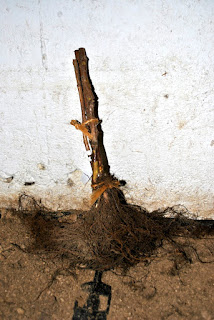 |
| internet photo |
Last week, I talked about raspberry varieties for northern gardens and some general raspberry knowledge that is useful to the home gardener. In this article, I'm going to talk about planting those raspberries.
As with most plantings, the key to success is starting with the proper site and good soil preparation. Raspberries like a sunny, well-drained location. They prefer sandy loam rich with organic matter, and a pH range of 5.5 to 6.5, or slightly acidic. That said, they do very well in my moderately alkaline clay soil. The key is to keep them in a location where water drains away, rather than sets and makes for soggy soil, and to keep the proper levels of organic matter in the soil. In clay, approximately 5% organic matter is a good range. In sandy soils, you can get by with about half that amount.
 |
| internet photo |
Adding organic matter and tilling it in for a year or even two years before you plant is helpful in incorporating the organic matter and also getting rid of any weeds that may be in the area. Having the soil tested if you don't know how much organic matter your soil contains or what the pH is might save you a lot of headache in the future. You can obtain instructions and soil test kits from your local land grant university extension office. They will even tell you what you need to add to make your soil the best it can be!
You should also stay away from garden plots where you have grown tomatoes, potatoes, peppers, and eggplant within the last four years. These plants can all harbor verticillium fungi that loves to attack raspberry roots.
I should mention, too, that while it is not a key to successful raspberry growth, there is one other thing to remember in choosing your site that is the key to not wanting to pull your hair out when you find raspberry suckers in the middle of your formal perennial garden (or any place else you don't want them). And believe me, pulling your hair out just might be easier than getting rid of rogue raspberry roots. Choose a site that gives your raspberries room to spread their roots, and where you can easily cultivate or otherwise eradicate unwanted raspberry suckers.
If you are planting more than one variety of raspberry, it is advisable to keep black raspberries separate from red or yellow varieties to minimize the spread of diseases. Black raspberries are more likely to carry these diseases, and they are very attractive to the aphids which carry those diseases from plant to plant.. If you have no space to keep them separated, you can do the next best thing by planting the black raspberries downwind, based on your prevailing wind direction at the planting site. This will keep the aphids from being blown to your other raspberry varieties as easily.
Red and yellow varieties can all be planted together, however, if you want to keep your varieties separate, you will want to give them plenty of space. If you plant multiple varieties close together, over time they are likely to become indistinguishable from each other, and the more aggressive varieties will choke out the less sturdy plants.
If you have friends or neighbors who grow raspberries, you probably know someone who is willing to give you some starts. This is tempting, but it can also be risky. This is tempting, because, after all, who can resist free plants? But this is risky because those plants are much more likely to harbor hidden diseases that they will bring into your patch. I recommend that in this case, you spend the money to buy from a reputable nursery or grower who can guarantee that the plants you receive are disease free and "virus-indexed". Raspberry mosaic viruses can devastate your patch and older plants from home gardens are much more likely to harbor these diseases.
 |
| internet photo |
Raspberries can be planted in rows or hills, depending on space and your personal preference. If you plant in hills, you will want to leave ample space on all four sides of each hill to be able to cultivate with whatever equipment you plan to use. If you plant in rows, bushes can be spaced about two to three feet apart within the row, but the rows should be far enough apart to easily pick between and to run whatever cultivating equipment you plan to use between the rows.
 |
| internet photo |
Set the roots firmly in the soil, keeping them at the same depth they were in the nursery when they were dug, or that they are in the pot if you are planting potted starts. Pat the soil firmly around the roots and water well. Trim the canes back to about eight to ten inches. Water well, and keep uniformly moist throughout the growing season.
 |
| internet photo |
Red raspberries will spread from suckers that grow up from both the crown and the roots. Those suckers will grow together to form a solid hedgerow, whether you plant them in rows or hills. They should be cultivated periodically to keep the base of the hedgerow no more than 12 to 18 inches wide to facilitate picking and pruning. Black and purple raspberries send out suckers only from the crown of the plant, so they do not form hedgerows. They are more easily maintained in hill plantings than red raspberries, and the hills should be planted about four feet apart.
Most raspberries do best with some sort of support. In the next blog installment, I'll talk about trellising, pruning, and other maintenance for raspberry plants.




